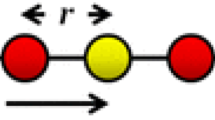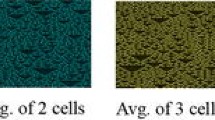Abstract
Cellular automata (CAs) have played a significant role in the study of complex systems. Recently, the recursive estimation of neighbors (REN) algorithm was proposed to extend a CA rule with a unit rule radius to rules with larger radii. This framework enables the construction of non-uniform CAs comprising cells that follow different CA rules. A non-uniform CA, referred to as fractal CA (F-CA), which comprises fractally arranged cells, inherits certain characteristics of basic CAs, including pattern replicability and time-reversibility of linear rules. In this paper, F-CAs based on linear rules, particularly the elementary CA #90 and #150, and life-like CA B1357S1357 and B1357S02468 are investigated. Cells in the F-CAs of #90 and B1357S1357 are separated into groups by their rule radius and each group has an independent lifetime. The explicitly constructed inverse rule of F-CA of #150 is more complex than that of F-CA. The complexity of the F-CA of B1357S02468 and its inverse CA is demonstrated by image scrambling. The F-CAs can be applied to encoding and decoding processes for encryption systems.












Similar content being viewed by others
References
von Neumann J (1966) The theory of self-reproducing automata. In: Burks AW (ed) Essays on cellular automata. University of Illinois Press, Champaign
Wolfram S (1986) Theory and applications of cellular automata. World Scientific, Singapore
Hansen PB (1993) Parallel cellular automata: a model program for computational science. Concurr Pract Exp 5:425–448
Ermentrout GB, Edelstein-Keshet L (1993) Cellular automata approaches to biological modelling. J Theor Biol 160:97–133
Ganguly N, Sikdar BK, Deutsch A, Canright G, Chaudhuri PP (2003) A survey on cellular automata
Chopard B, Droz M (2005) Cellular automata modeling of physical systems. Cambridge University Press, Cambridge
Kayama Y (2016) Extension of cellular automata via the introduction of an algorithm for the recursive estimation of neighbors. Artif Life Robot 21(3):338–344
Kayama Y (2016) Expansion of perception area in cellular automata using recursive algorithm. In: Proceeding of the fifteenth international conference on the simulation and synthesis of living systems, pp 92–99
Gerald E (2004) Classics on fractals. Westview Press, Boulder
Trochet H (2009) A history of fractal geometry. University of St Andrews MacTutor History of Mathematics. http://www-groups.dcs.stand.ac.uk/~history/HistTopics/fractals.html
Mandelbrot BB, Pignoni R (1983) The fractal geometry of nature, vol 173. WH Freeman, New York
Briggs J (1992) Fractals: the patterns of chaos: a new aesthetic of art, science, and nature. Simon and Schuster, New York
Falconer K (2004) Fractal geometry: mathematical foundations and applications. Wiley, Hoboken
Song C, Havlin S, Makse HA (2005) Self-similarity of complex networks. Nature 433(7024):392
Kayama Y (2018) Cellular automata in fractal arrangement. Artif Life Robot 23:395–401
Wolfram S (1983) Statistical mechanics of cellular automata. Rev Mod Phys 55:601–644
Wolfram S (2002) A new kind of science. Wolfram Media Inc, Champaign
Adamatzky A (ed) (2010) Game of life cellular automata. Springer, London
Eppstein D (2010) Growth and decay in life-like cellular automata. In: Adamatzky A (ed) Game of life cellular automata. Springer, Berlin, pp 71–98
Kayama Y (2011) Network representation of cellular automata. In: 2011 IEEE symposium on artificial life (ALIFE), pp 194–202
Fredkin E (1990) An informational process based on reversible universal cellular automata. Phys D Nonlinear Phenom 45(1–3):254–270
Reynolds CW (1987) Flocks, herds and schools: a distributed behavioral model. ACM Siggraph Comput Graph 21(4):25–34
Kayama Y, Koda Y, Yazawa I (2018) Fractal arrangement for 2D cellular automata and its implementation for outer-totalistic rules. In: Proceedings of thirteenth International Conference on Cellular Automata for Research and Industry, Springer, pp 328–339
Gardner M (1970) Mathematical games. Sci Am 223:102–123
Berlekamp ER, Conway JH, Guy RK (1982) Winning ways for your mathematical plays, vol 2. AK Peters, Natick
Acknowledgements
The author wishes to thank all the anonymous reviewers for valuable comments and suggestions. This research was supported in part by a grant from BAIKA Gakuen, Japan.
Author information
Authors and Affiliations
Corresponding author
Additional information
Publisher's Note
Springer Nature remains neutral with regard to jurisdictional claims in published maps and institutional affiliations.
About this article
Cite this article
Kayama, Y. Characteristics of fractal cellular automata constructed from linear rules. Artif Life Robotics 25, 8–16 (2020). https://doi.org/10.1007/s10015-019-00567-5
Received:
Accepted:
Published:
Issue Date:
DOI: https://doi.org/10.1007/s10015-019-00567-5




